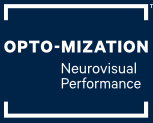Oculomotor function (eye tracking)
Saccadic (eye movement) abilities have been shown to be a key part of hand-eye coordination. Testing can make sure there are no deficiencies, and can uncover areas of eye tracking that can be improved.
Accommodation (focusing)
Accommodation ability is measured by using lenses to determine the ability of the brain to control how and where the eyes are focusing. This a key element of being able to quickly change focus during sport.
Peripheral integration/awareness
Our central visual system is what our brains use for seeing clearly and identifying what we are looking at. Our peripheral visual system is what our brains use for processing movement, motion, guiding eye tracking, balance, coordination and more. Key play-makers are able to focus on the ball/puck and still pay attention to where their teammates are. In basketball this is often referred to as court-vision. Peripheral integration is different than just visual field testing, which only tests if you can see it, not whether it’s being processed accurately.
Binocular function (eye teaming)
Convergence (eyes moving inwards) and divergence (eyes moving outwards) abilities need to be assessed. The most important tests for these abilities involve using prism to measure the ability of the eye to work together. Problems with convergence or divergence are often diagnosed as convergence insufficiency, convergence excess. Divergence insufficiency, divergence excess, vergence dysfunction, or binocular dysfunction. High performing athletes often do not have a diagnosable problem, but still have areas that can be improved.
Depth perception and spatial processing
Depth perception can be measured in a variety of ways. One of the ways this is measured is by using polarized 3D glasses and 3D targets. This does not always rule out problems with depth perception because it only looks at one aspect. Depth and spatial perception can also be tested by using various tests that are in real-space. Most athletes score well on the depth perception testing booklet, but may be slightly underperforming in other ways. Their hand-eye coordination may seem great, but even top baseball players saw significant changes to their stats when training was taken to the next level.
Visual-vestibular integration (how the eyes and inner ear work together)
Our brain is constantly comparing our visual and vestibular inputs. When your head moves, your eyes need to take it into account and counter the movement. This is what can make sure the eyes are still able to focus quickly when running, turning, or moving. For a racecar driver, it was the key to allowing him to focus faster and more accurately on the road while being jostled around.
Visual acuity (how small of a target that can be seen)
Visual acuity is tested on most routine exams. Visual acuity, and the glasses prescription required to see clearly is often the focus of most eye examinations. It can often be quite frustrating for people who feel like their vision is part of their post-concussion syndrome, but after having their prescription and eye health checked, they are told their vision is ‘fine’. Visual acuity and prescription is the testing done where you have to see the small targets and different lenses are used (“better one, or better two”) to determine what prescription allows for the best clarity. A common problem is that the way prescriptions are usually measured and given can result in glasses or contacts that actually make performance worse. It is important that a prescription for sport takes into account how the eyes and the brain work together.

